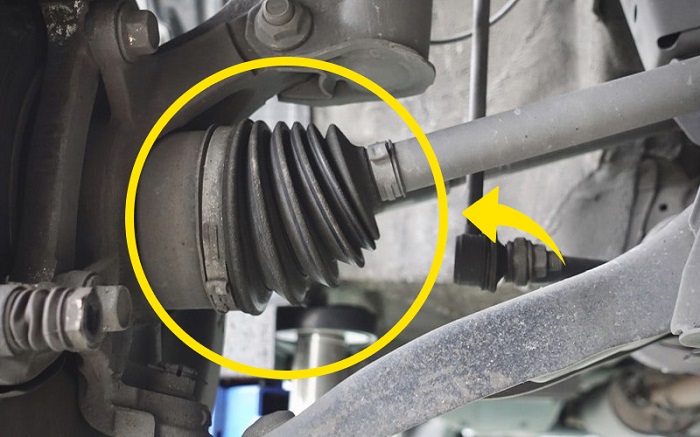
The CV or constant velocity axle is a vital car component tasked with transferring the pulling power from the transmission to the wheels. Throughout its lifespan, the CV axle endures quite a bit of stress and thus is sometimes known to fail. However, if you pinpoint any of these symptoms, you might be able to prevent further damage.
Signs of a bad CV axle:
- Difficulty steering
- Grease leaks
- Screeching, clacking, or knocking sounds
- Bounciness and lack of control
- Vibrations
- Weird noises while steering the car
- Worn out joints
Difficulty Steering
The CV axle transfers all the torque from the powerplant to the ground, as such, if the axle is out of place, making the car steer is likely to be an issue. This happens when you try to steer, but the car is not keen on changing direction. If this does happen, be sure not to drive the car before the issue is resolved. This can sometimes even be caused by an issue with the power steering system which can be equally as dangerous, as such, never drive a car that experiences difficulties while steering.
Grease Leaking
Constant-velocity joints are developed to efficiently transfer power through a variable angle without any losses of power of additional friction. These CV joints are protected by rubber boots which are often filled with Molybdenum disulfide, or as we know it – grease. These boots tend to wear out over time and leak grease all over the edges of your tires. If you come across lots of grease residue in your wheel well, it's more than likely that the issue points to a faulty CV joint which means that you should park the car up until you know more about the issue.
Screeching, Clacking, Or Knocking Sounds
If you hear any screeching, clacking, or knocking sounds, especially while turning, it could be a definite sign of a worn-out driveshaft/CV axle. This tends to happen if the CV axle starts to leak, and if not attended in an earlier stage it could result in an entire drive shaft replacement. Leaks such as these increase the levels of friction between moving parts which exponentially increases the wear and tear. In order to avoid having to pay huge amounts of money for a new CV axle, park the car up and ask for assistance.
Bounciness And Lack Of Control
Whenever your CV axle is near its imminent death, it usually starts to bounce the car in a fairly dangerous manner. When this does happen, it feels like you are off-roading, even while driving on perfectly smooth tarmac. As mentioned, this can be dangerous, so don’t drive the car until the issue is taken care of. Bounciness such as these tends to start at a later stage and it gradually increases as time goes on. If you don’t stop to fix the issue in time, this could also cause many other issues with other drivetrain parts.
Vibrations
Experiencing mild vibrations while driving a car is completely normal because the engine and many other components vibrate even while idling. However, if the vibrations are unnaturally intensive or they also cause weird noises, it is likely a symptom of a suffering CV axle. Vibrations such as these are usually fairly intense which means that you should not deem them as normal. However, if the vibrations are mild and barely noticeable, it does not always point to a faulty CV axle. Either way, take the car in for a diagnosis.
Weird Noises While Steering The Car
A common symptom of a faulty CV axle is unnatural sounds coming from the front wheel wells. The sound somewhat resembles thumping and it only appears while turning the wheel. This is of course unnatural and is most likely tied to a faulty CV axle. If these thumping sounds are followed by increased vibrations in the steering wheel it means that your CV axle is nearing its end if you don’t fix it in due time.
Worn Out Joints
As previously mentioned, CV joints are used to transfer energy without any friction or loss of power. This means that they are essential as far as an efficient and comfortable ride is concerned. Even though they are made to last a long time, they can sometimes wear out prematurely if the driving conditions are less than ideal. If you are hearing noises while accelerating in a straight line accompanied by strong vibration, chances are that the inner joint is to blame.
Solving CV Axle Issues
If you sense any issues with the CV axle, it's best to just take the car to an experienced mechanic who is trained to diagnose and repair these issues. However, if you have some spare time on your hand and the issue at hand is not severe enough, you can even try and fix the issue yourself. Be sure to look for grease leaks as these are the main point of focus as far as CV axle issues are concerned.
If the CV axle is leaking grease, you can top up the grease in order to try and fix the issue. Leaks such as these are commonly caused by fractures within the rubber boots which also enable dirt and grime to accumulate inside the boot itself which can significantly worsen the issue. The first thing you need to do is make sure that the grease is clean and not too dry.
If the grease is dirty, the best thing you can do is to clean the grease out completely and top the rubber boots up with brand new grease. You should also do the same if the old grease is too dry or hard to the touch. After adding new grease, be sure to test drive the car and if you are still noticing any of the aforementioned symptoms, you are likely in need of a full CV axle replacement. This should of course be left to the professionals.
Different Types Of CV Axle Joints
It's important to understand that there are a few different types of CV axle joints out there. This is essential to properly gauge how much money it takes to replace a broken joint. The most common type of axle joint is the Rzeppa CV Joint which is commonly known for the fact that it transfers torque by spherical wheels rather than through gear teeth.
A Plunge/Fixed joint combination is commonly used for FWD vehicles where a plunge joint serves as the inner joint and the fixed joint serves as the outer joint. Tripod/Ball-Type joints are two variations of a Plunge joint which are also used for FWD cars. RWD cars commonly use tripod joints because the power can be transmitted regardless of any angle shifting.
FAQ Section
How Much Does A New CV Axle Cost?
On average, a brand-new CV axle should set you back for at least $800 up to $1300. This is with included labor and a brand-new axle, but if you opt for a used one, you are looking at half that price. However, you don’t always have to buy a brand-new axle if the issues at hand are not all that serious. Fixing a faulty CV usually costs less than half of the amount it takes to buy a new one.
Is It Good To Replace A Single CV Axle?
You technically can replace a single CV axle, but it's always good to replace both if possible. Most cars start having issues with the right shaft because right turns are usually sharper when compared to most left turns. However, this usually means that the left shaft is not far from its end, so by replacing both you should be safe from axle issues for a long time.
Is Driving With A Bad CV Axle Dangerous?
Driving with a bad CV axle is dangerous, and you should skip driving the car before the issue is resolved. The axle is a vital drivetrain component that affects both steering and acceleration. As such, if something breaks, you are likely going to experience it through a myriad of problems. If you hear slight noises while turning, you can drive the car if necessary, but if you experience extreme vibrations and bouncing, park the car up immediately.
How Long Should A Functional CV Axle Last?
Automakers tend to cover CV axles under warranty which should keep you safe for 4-5 years, but they can last a lot longer than that. If you take proper care of your car and you don’t drive it through treacherous terrain, your CV axle could in theory last you a lifetime.
Can A Bad CV Axle Cause Transmission Issues?
A bad CV axle can cause many problems including ones associated with the transmission. Because the CV axle is tasked with transferring the power from the engine and transmission to the wheels, any issue you experience with the axle can easily cause spread to the transmission. This is also why you should repair your CV axle soon enough.
About the authors
The CarAraC research team is composed of seasoned auto mechanics and automotive industry professionals, including individuals with advanced degrees and certifications in their field. Our team members boast prestigious credentials, reflecting their extensive knowledge and skills. These qualifications include: IMI: Institute of the Motor Industry, ASE-Certified Master Automobile Technicians; Coventry University, Graduate of MA in Automotive Journalism; Politecnico di Torino, Italy, MS Automotive Engineering; Ss. Cyril and Methodius University in Skopje, Mechanical University in Skopje; TOC Automotive College; DHA Suffa University, Department of Mechanical Engineering






Add comment